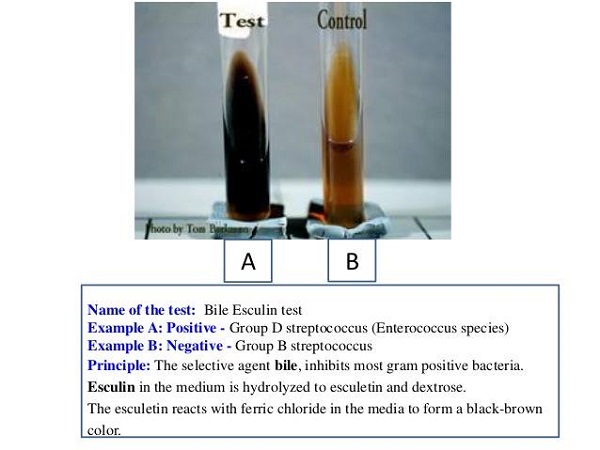Bile Esculin Test- Principle, Procedure, Result Interpretation and Limitation
Bile Esculin Test- Principle, Procedure, Result Interpretation and Limitation
Bile Esculin agar (BEA) is used for this test. BEA is a selective and differential medium which is presumptively used to identify Enterococci and group D Streptococci based on the ability of an organism to hydrolyze esculin. Bile esculin agar contains oxygall (bile salts, first selective ingredients) to inhibit the growth of other gram positive organisms other than Enterococci and group D Streptococci. It contains sodium azide (second selective ingredients) to inhibit the growth of gram negative organisms. It also contains nutrients esculin and ferric citrate. Esculin (differential ingredient) is a fluorescent compound and its hydrolysis can be observed by a loss of fluorescence.
Bile esculin disk is used for the rapid detection of esculin hydrolysis in presence of bile for differentiating group D Streptococci from non-group D Streptococci.
Principle
Bile esculin test is based on the hydrolysis of esculin into glucose and esculetin (6, 7-dihydroxy-coumarin) by a micro-organism that produce an enzyme esculinase. Esculetin reacts with an iron salt (ferric citrate) in the medium to form a phenolic iron complex which produces a dark brown or black color.
Esculin + Acid → β-D-glucose + Esculetin
Esculetin + Fe3+ → Dark Brown Color
Procedure
A. Tube Test
- Using sterile loop, pick one or two colonies from an 18-24 hours culture.
- Inoculate onto the surface of slant of bile esculin medium with an S-shaped motion.
- Incubate the inoculated tube at 35-37°C for 24 hours.
- Observe the result.
B. Disk Test
- Moisten disk with a single drop of distilled water.
- Using a sterile loop, pick two or three well-isolated colonies from an overnight culture.
- Inoculate on the disk.
- Allow to react at room temperature for 10min.
- Observe the disk for the development of a dark brown or black color.
Result Interpretation
Positive: Blackening of more than half of the agar slant, if the medium containing ferric ammonium citrate is used.
NOTE: In case of esculin broth without iron citrate, positive test means blackening of the broth after addition of the ferric reagent or by the loss of fluorescence of the medium.
Negative: No blackening of medium.
OR If the agar slant is less than half darkened or medium will fluoresces under UV light.
Positive Disk Test: Development of a dark brown or black color.
Negative Disk Test: Remains colorless.
Quality Control
Bile esculin positive: Enterococcus faecalis ATCC 29212
Bile esculin Negative: Streptococcus pyogenes ATCC 19615
Limitation
- Some micro-organisms such as Escherichia coli have a β-glucosidase and will react in this test after prolonged incubation. Prolonged incubation should not be used if the test is being used to detect only constitutive β-glucosidase.
- H2S which is produced by several organisms during metabolism, also reacts with iron to produce black complex which interferes with the interpretation of the esculin hydrolysis test.
- If the inoculum is too great or the concentration of bile is less than 40%, viridans group streptococci other than S.bovis can give a positive reaction on bile-esculin agar.
- A heavy inoculum on BEA may cause interpretation of the bile esculin test difficult to read. Excess inoculum decreases the ability of the bile to inhibit growth of other gram-positive organisms that may hydrolyze esculin.

